UPDATE
This article has been superseded by a more recent survey.
View the 2023 bookmaker margin survey results.
This article summarises the 2013 edition of our annual bookmaker margin survey. Fifteen bookmakers plus the betting exchange Betfair were included in the study. This follows up on our 2011 and 2012 surveys. In addition to the popular head-to-head, line and over/under markets, this year’s survey also includes selected futures markets and the number of markets offered per fixture.
One difference between the publication of margins this year compared to last is we have subtracted 1 to display the margin as a percentage. We now state the margin as 4.2% rather than 1.042 as in previous studies.
What are Bookmaker Margins?
When a bookmaker sets the odds for a market they first estimate the probability of each possible outcome. For example, in a market on a coin toss winner, the bookmaker will assume the probability of Team X winning is 50%. When using decimal odds, the fair odds for the wager equal the reciprocal of the bookmaker’s estimated probability, in this case 1 / 0.50 = 2.00. To fund their operation, the bookmaker adjusts these odds downward to create a profit margin for the market. For example, typical bookmaker odds on Team X winning a coin toss are 1.91. The difference between the published odds (1.91) and the fair odds (2.00) is the bookmaker margin.
The bookmaker margin is a measure of the bookmaker’s profit margin for an event and is a hidden transaction cost for punters. This profit is how bookmakers finance their services but bookmakers vary in the margins they apply. From a punter’s perspective, the lower the margin, the better. The difference between 1.90 and 1.92 line odds may not seem significant for a single wager, but when betting repeatedly this difference has a compounding effect. This can easily make the difference between winning and losing money.
Calculating Bookmaker Margins
When using the decimal odds system, which is popular in Australia and Europe, calculating the bookmaker margin for a market is easy. The margin equals the sum of the reciprocals of the odds, minus one. Below are calculation examples using two-outcome and three-outcome events.


The margin is amount by which the market exceeds 100%.
Note that for a 100.0% market the margin is zero. If you compile the best available odds across a number of bookmakers and the combined market is below 100.0%, then the margin is negative, which means an arbitrage opportunity may exist.
Interpreting Bookmaker Margins
The margin measures the bookmaker’s profit if they were to receive wagers on each outcome in proportion to the odds. Suppose a bookmaker offers decimal odds a on outcome A and odds b on outcome B. If proportion b/(a+b) is wagered on outcome A and a/(a+b) is wagered on outcome B, then the bookmaker will receive the same profit regardless of the result.
For example, recall that the bookmaker margin for the two-outcome event above was 3.5%. Suppose $100,000 in total is wagered on the market, with:
(1.64/(1.64 + 2.35)) x $100,000 = $41,102.76 wagered on Oklahoma City and
(2.35/(1.64 + 2.35)) x $100,000 = $58,897.24 wagered on Denver.
|
Depending on the outcome, the bookmaker will pay out one of the following two amounts: If Oklahoma City wins: $41,102.75 x 2.35 = $96,591.48 The bookmaker accepts $100,000 in wagers but only pays out $96,591.48 to the winners. The profit margin is ($100,000 – $96,591.48)/$96,591.48 = 3.5%, as calculated by the margin earlier. A bookmaker will rarely receive wagers that are perfectly in proportion to the odds, but over a countless number of events the bookmaker margin will equate to the average profit margin across all events. To provide perspective on how odds relate to margins, the table on the right compares equal line odds (bets with a 50% chance of winning) to their respective margins. Note that 2.00 odds equate to a margin of 1.00 (100%), where the bookmaker makes no profit on the market. |
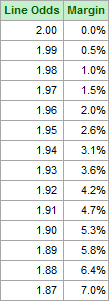 |
Bookmaker Margin Survey
Bookmaker margins have been calculated for fifteen bookmakers plus the betting exchange Betfair. The margins were calculated using odds observed on the Friday leading up to the weekend’s round of fixtures. The Betfair odds have been adjusted to incorporate a 5% commission. In instances where two bookmakers offered identical odds we have combined them into the same column. For example, Centrebet and Sportingbet have shared the same odds since the owners of Sportingbet acquired Centrebet.
Our survey results are separated into the following sections:
- Fixtures – a look at head-to-head, line and total score margins
- Lines – a comparison of even lines for popular sporting codes
- Futures – a look at margins on futures markets, such as the AFL Premiership
- Markets – a basic survey of the number of markets offered per event
Margin Survey – Fixtures
The margins in the table below reflect the average margin across a sample of fixtures for each league. The margins have been calculated for head to head, line and over/under markets, where available. These margins have then been averaged to give a representative margin per sport. The second column denotes which markets were used for each sport, where:
L = line market (e.g. Melbourne Storm -6.5)
H = head-to-head market (e.g. Melbourne Storm to win)
O = total score market (e.g. over/under 38.5 points)
The lowest average margin for a given sport is highlighted in green, while the highest margin is highlighted in red. An “N/A” cell means odds were not available for that particular sport or market during the survey.
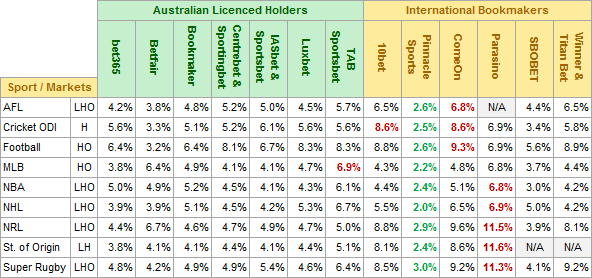
The next table displays the average margins by market type, where:
Line = line market
H2H = head-to-head market
O/U = over/under market
Because 10Bet, ComeOn, Parasino, Winner and Titan Bet use three-outcome head-to-head markets (home team / draw / away team) for rugby league and rugby union, their head-to-head margins are significantly higher as a result. The “Excl. Rugby – H2H” row displays each bookmaker’s average head-to-head market for sports excluding rugby league and rugby union to provide a more “apples with apples” comparison.

When ranking the bookmakers in ascending order by the average of their line, head-to-head (excluding rugby) and over/under margins, the services fall into the following tiers:
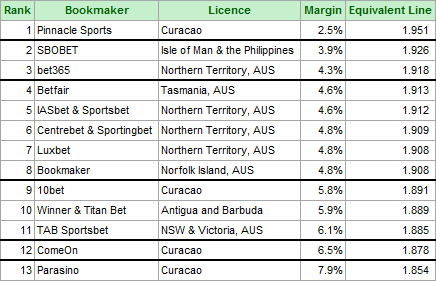
Pinnacle Sports remains in a league of it own, with margins that are often half that of its competitors. Pinnacle Sports markets itself as a low margin bookmaker and our research validates that claim.
SBOBET is another strong performer out of the non-Australian licensed services. Like Pinnacle Sports, SBOBET markets itself as a low margin bookmaker, as validated by our survey. bet365 has improved since 2012, with an average margin that is now lower than that of the major Australian bookmakers. Much of this result is due to bet365 becoming licensed in Australia. This survey is biased towards Australian sports and bet365’s expansion into Australia has resulted in more a competitive coverage of Australian leagues.
The largest group of bookmakers fall into the third tier. Betfair – using 5% commissions – slipped in our rankings, however it should be noted that its margins vary drastically depending on the popularity of each event. Betfair remains a better value option for head-to-head and over/under betting than the major Australian bookmakers, however Betfair’s biggest weakness – due to poor liquidity – is line betting. The 6.1% average line margin pushed its overall margin up. The increase in Betfair’s margin is more a reflection on the change in survey methodology than anything else. Also in this tier are IASBet, Sportsbet, Centrebet, Sportingbet, Luxbet and Bookmaker.com.au. Note that IASBet and Sportsbet share the same owner, which is why they offer the same odds. The same goes for Centrebet and Sportingbet. The only differences between these pairs of services are their promotions and competitions.
There is a sizable drop off between the group above and the next bracket, which consists of the international bookmakers 10bet.com, Winner and Titan Bet, as well as TAB Sportsbet. The international bookmakers are generally competitive for football and the major American codes, but their results suffered from our heavy emphasis on the major Australian codes. TAB Sportsbet once again is the poorest performer of the Australian bookmakers.
The bookmakers with the highest margins were ComeOn and Parasino. Both services offer sports betting as part of a larger product group that includes casino and poker sites. We get the impression that their focus is on their casino products rather than their sportsbooks.
Line Survey
The table below summarises even line odds for popular sporting codes. The results are displayed as decimal bookmaker odds rather than margins.
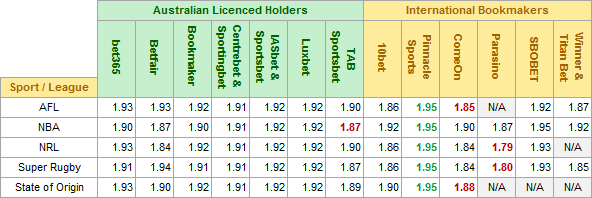
Pinnacle Sports is the standout performer, with even lines of 1.952 offered on most sports. bet365 was another strong performer. Note that IASBet and Sportsbet consistently used 1.92 line odds, however these odds were recorded on the Friday leading up to the events. For Super Rugby and NRL fixtures, both bookmakers – who are owned by the same company – actually open with 1.90 odds and then shift to 1.92 on Friday.
Margin Survey – Futures
The table below summarises our survey of the margins used on futures markets. In the event where some bookmakers offered fewer selections than others, we only included the shortest selections limited by the smallest available selection. For each league the number of selections surveyed in included is shown in brackets. With the English Premier League, for example, the shortest six teams’ odds were used to calculate the margin for each bookmaker.
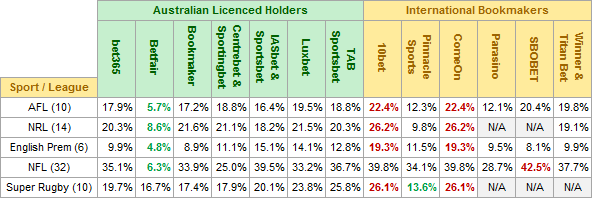
Betfair dominates this category, with commission-adjusted margins that are substantially lower than standard bookmakers.
Markets Survey
The table below shows the number of markets offered per fixture for popular Australian leagues. For example, if a bookmaker offers head-to-head, line and total score markets for an upcoming AFL fixture, then a total of three markets is available for that event. The actual number of markets offered varies drastically between each fixture as well as from one week to the next, so the results below provide a general indication only. For each league the event with the highest number of markets was used.

The Australian-licensed bookmakers dominate when it comes to the popular Australian codes. This highlights why an Australian bookmaker membership is a must when wagering on Australian sports. While they weren’t covered in the survey, we observed greater parity between the Australian and international bookmakers when it came to international football leagues and the popular American codes. One exception is Pinnacle Sports, which rarely offers more than three markets per event.
The number of markets for an event generally rises in the lead up to the fixture, with the maximum number of markets offered just before the event commences. For example, with NRL fixtures, on Thursday or Friday the most markets offered for the upcoming round will be on the Friday fixtures, while the fewest markets are offered for the Monday night fixture. The number of markets for the Monday night fixture then increases over the weekend and peaks on Monday.
Conclusions and Notes
This survey follows up on our 2011 and 2012 bookmaker margin surveys. Pinnacle Sports is once again the standout performer, with margins that are often half that of its competitors. The only category Pinnacle Sports doesn’t dominate is futures betting, where Betfair comes into its own.
The major Australian bookmakers offer similar value, with the exception of TAB Sportsbet, which offers the least value of the Australian bookmakers. bet365 improved this year in both absolute and relative performance. The major reasons for this improvement are our surveys are heavily biased towards Australian sporting codes and bet365’s coverage of Australian sports has improved as a result of their expansion into Australia.
International bookmakers like 10Bet were competitive for football and the popular American codes, but were hurt by their performance in the Australian codes that were weighted heavily in this study. International bookmaker memberships remain a good complement to Australian memberships, however, due to their provision of online, in-play betting.
While the reported margins in this survey are generally lower than in previous studies, the methodology used in this survey differs from 2011 and 2012, which makes year on year comparisons less relevant.
It should be noted that higher margins enable bookmakers to offer more services. Pinnacle Sports offers a simple betting service with limited markets, while a higher margin bookmaker like bet365 offers a flashier user interface, a larger array of sports and markets, live video feeds and access to team statistics.
While high margins may deter you from obtaining membership with a particular bookmaker, it can occasionally be beneficial to maintain an account with that service within a portfolio of memberships. This is because any given bookmaker may still provide the best odds for a particular outcome.
Finally, please note that this survey was conducted between June and July, 2013. The margin averages were heavily dependent on the sample of sporting events used. Comparative margin levels may change over time and will differ for sports and leagues not covered in this survey.

